| کد مقاله | کد نشریه | سال انتشار | مقاله انگلیسی | نسخه تمام متن |
|---|---|---|---|---|
| 189012 | 459671 | 2012 | 8 صفحه PDF | دانلود رایگان |

N,N-diethylacrylamide (DEA) and 4-vinylpyridine (4VP) were polymerized into P(DEA-co-4VP) copolymer hydrogel films with immobilized glucose oxidase (GOD) on electrode surface with the simple one-step procedure under mild conditions, designed as P(DEA-co-4VP)-GOD. Cyclic voltammetric (CV) response of ferrocenedicarboxylic acid (Fc(COOH)2) probe at P(DEA-co-4VP)-GOD film electrodes was very sensitive to environmental pH, temperature, and sulfate concentration. For example, in pH 5.0 buffers, the CV response of Fc(COOH)2 was quasi-reversible with quite large peak heights at 25 °C for the films, showing the on state; while at pH 9.0, the peaks were greatly suppressed and the system was at the off state. This pH-sensitive on-off switching behavior of the films toward the probe was reversible and could be repeated for many times between pH 5.0 and 9.0. Similarly, the film system could be switched on-off reversibly when the temperature was changed between 25 and 39 °C, or when the concentration of Na2SO4 was changed between 0 and 0.50 M. This triply responsive property could be further used to realize triply switchable electrochemical oxidation of glucose catalyzed by GOD immobilized in the films and mediated by Fc(COOH)2 in solution. The responsive mechanism of the system was also explored and discussed. The pH-sensitive property was attributed to the electrostatic interaction between the P4VP component of the films and the probe at different pH, while the thermo- and sulfate-sensitive behavior was ascribed to the structure change of PDEA constituent of the films with temperature and Na2SO4 concentration, respectively. These “smart” films combine the unique stimuli-responsive properties of both P4VP and PDEA with enzymatic reactions and may be used to fabricate a novel type of multi-controllable electrochemical biosensors based on bioelectrocatalysis.
► P(DEA-co-4VP) copolymer films containing GOD are polymerized on electrode surface.
► The one-step polymerization is simple and takes only 20 min at room temperature.
► CV response of Fc(COOH)2 at film electrodes is sensitive to pH, T, and csulfate.
► Based on this, the triply switchable bioelectrocatalysis of glucose can be realized.
Journal: Electrochimica Acta - Volume 60, 15 January 2012, Pages 456–463